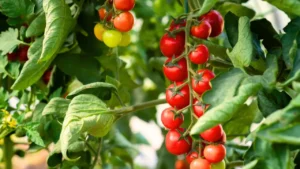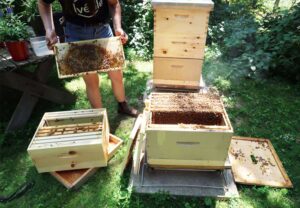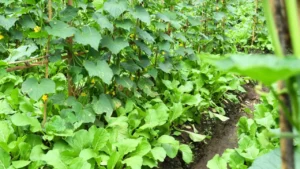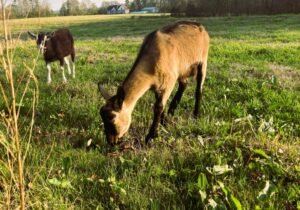
EUquandryart.png
A grafted grapevine, image from Washington State University Extension
Around the world today virtually all wine grapes are grown on these “American” rootstocks because they can provide protection from soil-borne pests while allowing the traditional varieties to achieve the desired fruit qualities that made them so desirable. Rootstocks are used for almost all perennial crops and also for high value vegetable crops like fresh market tomatoes.
There are also two serious foliar diseases that also made the jump from North America to Europe in the 1800s. The first was a disease called Powdery Mildew and it causes loss of yield and quality as it grows on the exterior of the leaves and fruit. Vitis vinifera is highly susceptible to this disease.
Grape Powdery Mildew infection of a developing grape cluster. Photo by Laura Jones/Univ. California, Davis
The solution that was found is probably the oldest known pesticide, elemental Sulfur. This “natural” mineral product was found to control the disease but only if the grapes were “dusted” with something like 10 pounds/acre of sulfur every 7 to 10 days for much of the season until the fruit begins to ripen (a stage called veraison in grape-speak). Sulfur is not very toxic to eat or drink, but it is an eye and skin irritant that can make it quite unpleasant to work in a vineyard. There is also some evidence that as with other dusts, sulfur can increase the risk of asthma among the children who live near the places were dust products are applied. California has recently restricted the use of sulfur and other dusts near populated areas. “Wettable” forms of sulfur can still be used without the respiratory problem and that is still a part of integrated pest management systems for grapes. However; most modern grape growers use sulfur more sparingly because newer and more effective “synthetic fungicides” have been developed which require far smaller doses at longer intervals and which are in the EPA toxicity class IV described as “essentially non-toxic” by ingestion. I remember a time in 1978 during my second season being out in California vineyards for my graduate research that I was amazed to smell a beautiful floral aroma during the grape bloom period – something I had not experienced the season before. It was because I was in a block treated with the first example of these new fungicide options instead of the normal odiferous and irritating sulfur. I have a podcast about that event. Grape growers who choose to grow for the organic market are not allowed to use these more modern tools and must therefore depend on high use-rate options like sulfur and something called “petroleum distillates” (think mineral oil for the later). Thus, this is just one example of how the EU Field to Fork strategy embodies conflicting goals if it wants to reduce pesticide use and the push for more organic production.
Grape Downy Mildew sporulating on the bottom of a leaf. Photo by Mark Longstroth, Michigan State Univ. Extension
There was another “intruder” fungus pest that originated on North American grapes and then caused even more severe problems for the European industry in the 1870s. It is called downy mildew. The solution that was ultimately found to this disaster was another very early pesticide. It was discovered by a French botanist named Pierre Millarday who noticed a particular vineyard along a roadside that stood out by exhibiting much less damage from the new disease. He learned that the grower had applied copper sulfate combined with lime as a way to make the fruit look unappealing so that people passing by would stop helping themselves to his grapes (you can see an image of this blue coating in this article in Wine Spectator).
That “natural” pesticide became known as the Bordeaux mix and it saved the grape industry. It was also a much-needed solution for a related disease on potatoes that had cause the famous Irish Potato Famine in the same era. Various copper-based products do work against these pests and many are approved for use in organic production, but unfortunately they are quite toxic to aquatic organisms and are persistent in the environment since the mineral copper is copper and it isn’t going to break down to innocuous components the way that many other natural or synthetic chemicals do over time. After years of use, copper fungicides build up in vineyard soils and can become toxic to grape roots. Many European organic growers have had to abandon their organic status because of these soil issues. Copper fungicides also require high use-rates (4-6 pounds/acre) and frequent applications because the copper is easily washed off by rain.
Once again, many low toxicity, highly effective and environmentally safe synthetic fungicides that have been developed to fight downy mildew, but those options are not allowed to be used by Organic growers. European regulators are not fans of these copper fungicides, but their politicians have made exemptions for their own grape growers while at the same time setting up barriers to more benign products that have met rigorous standards in other countries.
Organic growers also have limited options for the control of mold fungi that can infect the grapes as they become ripe. That sort of “bunch rot” is very bad for wine quality, but a disease that is well addressed with safe, modern synthetic fungicides while organic growers still depend on things like copper. Chemical herbicides are also desirable for grape production so that there isn’t a need for erosion-causing mechanical plowing to take care of weeds in the vine rows. Tillage is still the main option for Organic growers. So, in all these cases the EU’s pesticides and organic goals are in conflict with one another when it comes to that iconic industry
As mentioned earlier, there are several wild grape species that are more resistant to powdery and downy mildew. Theoretically traditional breeding methods could be used to transfer some of those genes. Conventional breeding of grapes is possible but slow, and it has been used to develop things like seedless table grapes with new colors and flavors. Some new wine grape varieties with disease resistance from wild grapes have been developed by breeders working for the University of California, and they were repeatedly “back-crossed” so that the final result was a variety with 95% vinifera genes. But because of tradition and some remaining wine quality questions, almost all the wine grapes of that state and other grape growing regions around the world are still the traditional European varieties.
With modern genetic technologies it is now possible to work with only one or a few genes from the wild grape species that confer pest resistance and do so without any effect on the thousands of other genes in the storied cultivars. This sort of precision is now much more feasible because of the genome editing technologies that are generating excitement for many applications in both medicine and agriculture. But the EU as a whole has been very resistant to accepting “GMOs” methods even though their own scientists have long argued that such changes do not represent any greater risk to public health or the environment than do traditional means of breeding. Scientists at Rutgers University and with the USDA are working now on using this approach to get downy mildew resistance into Chardonnay.
There is some hope in the scientific community that European activists and political authorities will take the logical step of saying that they can consider these modern genome editing technologies differently from how they responded to first generation genetic engineering methods. There is at least a promising mention of such technologies in the EU’s Farm to Fork Strategy
“In response to the request of Member States, the Commission is carrying out a study which will look at the potential of new genomic techniques to improve sustainability along the food supply chain.”
Some are even optimistic that traditionally anti-GMO groups will make a distinction for the new methods. Ideally the EU might take reasonable approach of combing state of the art genetics with the sort of low hazard synthetic chemical options that would still be important in order to avoid selecting for fungal resistance to traits a grower would need to last for decades in a new vineyard planting. That would also relieve the wine industries in other countries from having to cater to EU trade barriers in the choices they make about how to produce their crops.
Europeans are not likely to abandon their taste for wine and they don’t have to in order to pursue their legitimate goals. Organic isn’t the solution here. Instead what is needed is respect for the science and more effective communication of the actual safety story behind modern agriculture. There is an excellent explanation written by the European Food Safety Authority (EFSA) that describes how robust the approval system is for safe pesticide standards, and this is confirmed by academic experts as well. But all too often in Europe, politics trumps science. Let’s hope we might someday raise a toast to a more constructive and science-driven solution to the EU’s grape quandary.
Source link
2020-11-25 13:38:00
Karl Hoffman is a distinguished agriculturalist with over four decades of experience in sustainable farming practices. He holds a Ph.D. in Agronomy from Cornell University and has made significant contributions as a professor at Iowa State University. Hoffman’s groundbreaking research on integrated pest management and soil health has revolutionized modern agriculture. As a respected farm journalist, his column “Field Notes with Karl Hoffman” and his blog “The Modern Farmer” provide insightful, practical advice to a global audience. Hoffman’s work with the USDA and the United Nations FAO has enhanced food security worldwide. His awards include the USDA’s Distinguished Service Award and the World Food Prize, reflecting his profound impact on agriculture and sustainability.







